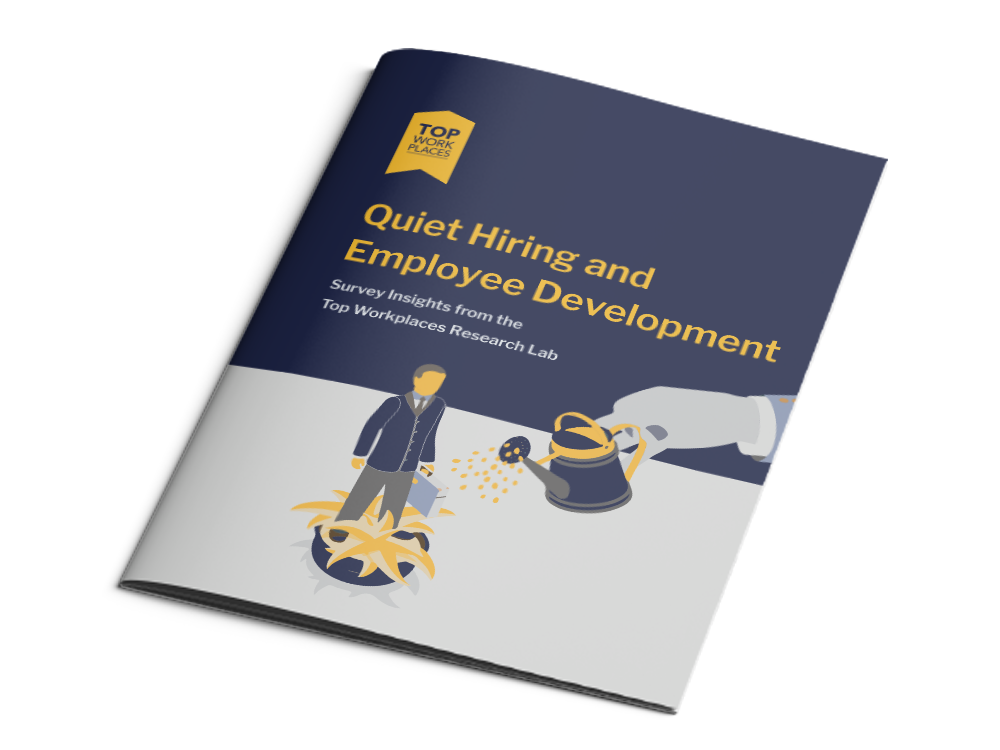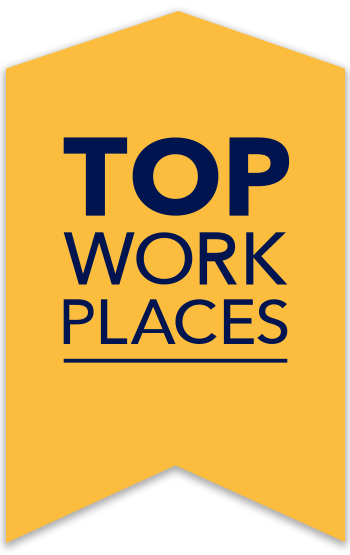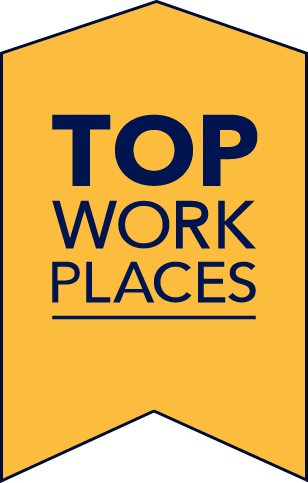
Get employee development and quiet hiring insights from the Top Workplaces Research Lab.
The 2022 Energage Workplace Survey study revealed that most employees feel they are getting the formal training they want. They also said their managers are helping them to learn and grow. Still, two or three out of every ten employees feel more employee development can be done. So, while these findings are positive, there is plenty of room for improvement.
Employee development is a crucial aspect of building a successful organization. Investing in employee development benefits individual employees and contributes to the business’s growth and success.
Employee development training programs aren’t limited to formal training. Some of the greatest opportunities are new and challenging projects that help both employees and the organization grow. This blog post explores employee development, its benefits, challenges, and how quiet hiring can support employee development initiatives.
What is employee development?
Employee development provides learning opportunities and resources to individuals to enhance their skills, knowledge, and abilities in their current and future organizational roles. A culture of employee development emphasizes the importance of continuous learning and growth, encouraging employees to take ownership of their development and providing them with the necessary support to do so.
Benefits of employee development
Employee development plays a crucial role in building a people-first workplace culture. By prioritizing the growth and development of their employees, leaders demonstrate a commitment to their people and create a culture that fosters learning, growth, and innovation. It also leads to the following:
- Increased job satisfaction and motivation
- Attracting top talent
- Minimizing employee turnover
- Improved productivity
Learn More: Benefits of Training & Development
Types of employee development
Top Workplaces research suggests 84 percent of organizations choose on-the-job training for employee training and development. Other top approaches include:
Informal and on-demand learning resources
Learning opportunities employees can access at any time and their own pace. Examples include online courses, webinars, podcasts, blogs, and videos. Informal and on-demand learning resources help employees to develop new skills and knowledge. Plus, it’s a great way to supplement more structured training programs.
Unstructured mentoring and coaching
This type of employee development involves pairing an employee with a more experienced colleague or mentor who can provide guidance and support. Unlike formal coaching or mentoring programs, it is less structured and may occur on an ad-hoc basis.
Manager career discussions
1-on-1s are a great way to uncover career aspirations and development goals. Managers can also provide feedback on an employee’s performance and suggest areas for improvement. It’s especially beneficial for employees looking to advance within the organization.
Formal training
Employee development training programs involve structured learning, often led by internal or external trainers. Formal training can include workshops, seminars, classes, and certification programs. Choose this type of employee development to introduce new skills and knowledge to employees, especially regarding compliance training, technical skills, or leadership development.
Learn More: Types of Employee Training
Employee development challenges
While there are many reasons why employees leave, a significant factor is a lack of development. Top Workplaces research recently revealed three of the top employee challenges:

Here are some other common challenges that can hinder your efforts to create a strong culture of growth and development:
Fear of losing talent
Sometimes professional growth can take employees out of your organization. Leave the door open for your talent to return when your paths align again.
Managers who don’t support development
Remind them that employee growth is the organization’s advantage and provide resources to support that.
Being unaware of employee aspirations
Get to know employees as individuals. Discuss career tracks and opportunities to advance within the organization so employees know better what to expect.
Employees who don’t own their development
Managers are coaches and advocates. And while employees need manager support to succeed, they need to take charge of their growth and development.
Employee development and quiet hiring
Quiet hiring is a popular buzzword used to describe how organizations are finding alternatives to hiring new employees. In reality, it’s just a fancy name for tried-and-true practices businesses have used for decades.
Instead of searching for new employees, quiet hiring can include relying on contractors, internal promotions, and asking current employees to take on additional work or roles. A recent Top Workplaces Research Lab survey revealed:
- 98 percent of responders practice internal promotions.
- 87 percent utilize stretch assignments.
- 74 percent work with contractors as a hiring alternative.
Internal promotions and stretch assignments can be a powerful way to demonstrate a commitment to employee development. By offering employees the opportunity to advance within the organization, leaders can encourage a learning, growth, and development culture.
Quiet hiring can also help retain top talent and increase employee engagement by providing a clear path for advancement. Companies can also benefit from employees already familiar with the organization’s culture, values, and operations, leading to a smoother transition and increased productivity.
Employee development best practices
By implementing effective employee development best practices, you can overcome common challenges and create a culture of growth and learning that can improve employee retention and drives business success.
1. Connect with employees
Know employee career aspirations, check their progress, provide guidance, and discuss bigger-picture topics.
2. Provide constructive feedback
Some people shy away from feedback, but performance discussions are critical to employees performing well and continuing to grow.
3. Encourage employees to pursue internal positions
Make sure new job opportunities are posted internally. Encourage employees to apply and aim to prioritize them as applicants.
4. Look for cross-training opportunities
Encourage managers to watch for cross-training or development opportunities during interdepartmental meetings and discussions.
5. Provide manager training
Develop managers as coaches who can help employees to think through issues, overcome business challenges, and improve decision making.
6. Give employees new opportunities
Recommend employees for projects that expand their knowledge and skills. Discuss employee progress with other leaders to ensure their good work is on people’s radars.
7. Offer skill development training
Provide employees opportunities to learn skills relevant to their work and long-term goals. Offer real-world applications and challenge employees with stretch assignments to ensure continued growth.
8. Incentivize managers for employee development
Equip managers with resources to support employee development. Ensure they are motivated to help employees grow, even if it results in team transitions.
Learn More: Improving Training and Development Strategies
Employee development supports a culture of success
Employee development is essential for the growth and success of any organization. By investing in employee development and using quiet hiring strategies, organizations can:
- Foster a culture of learning and growth.
- Equip employees with skills and knowledge.
- Build a strong workforce.
- Contribute to the organization’s success.
Top Workplaces for employee development
Employee development is one of the drivers of employee engagement. How can you determine if your employees are satisfied with your company’s growth and development efforts? The employee survey feedback captured as part of Top Workplaces participation tells you what matters most to them.
Explore the award-winning companies that prioritize and excel at employee development:
See the Top Workplaces for Professional Development
See the Top Workplaces for Formal Training
Does your company deserve recognition for its people-first culture? Nominate your organization for Top Workplaces, the employer recognition program that offers awards in 60+ regional markets as well as national awards for culture and industry excellence.

 Stand out with an award-winning
Stand out with an award-winning